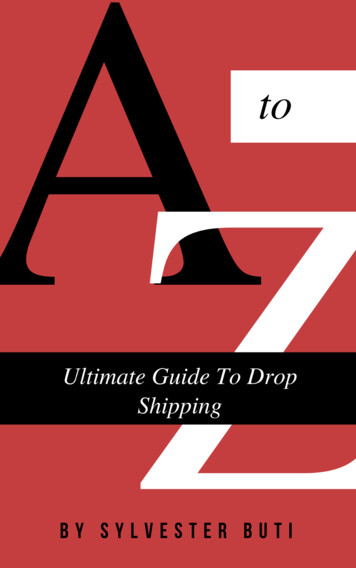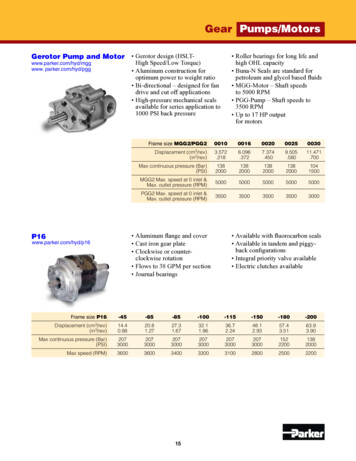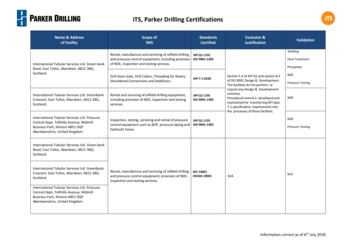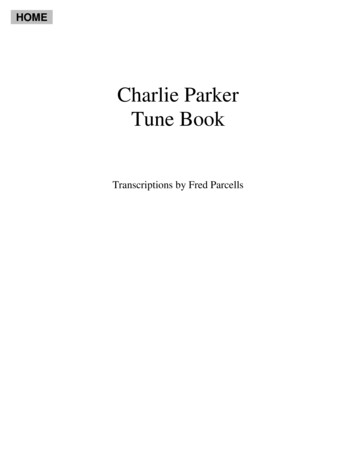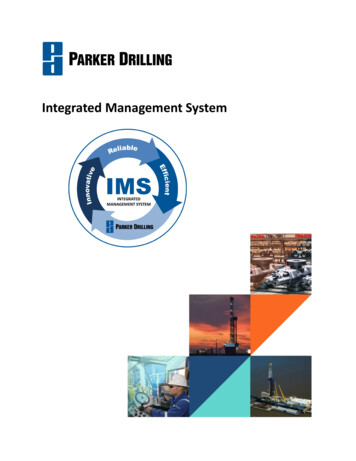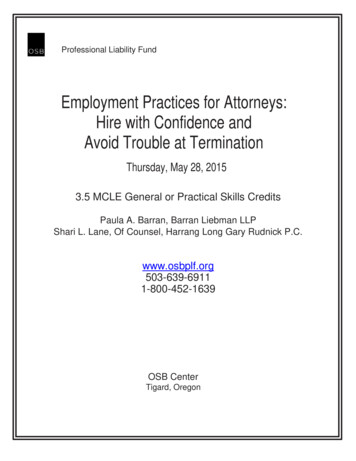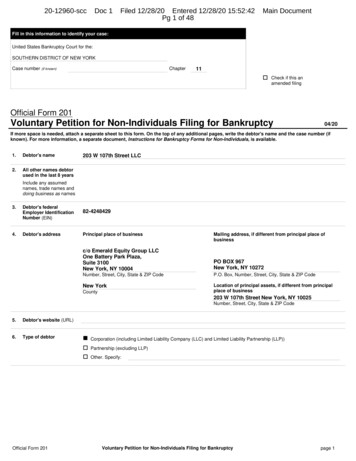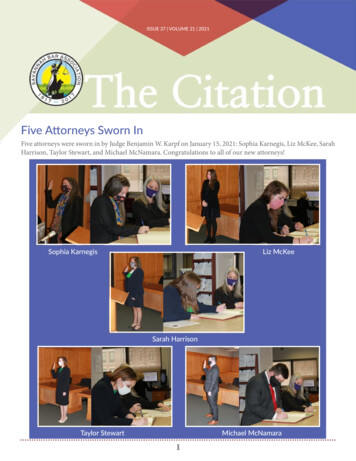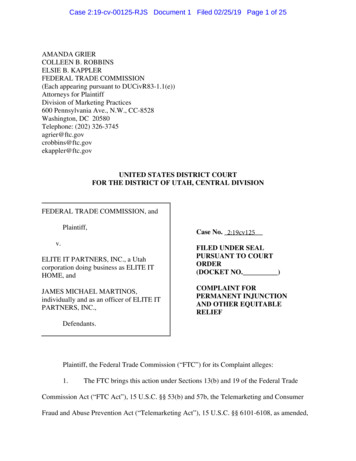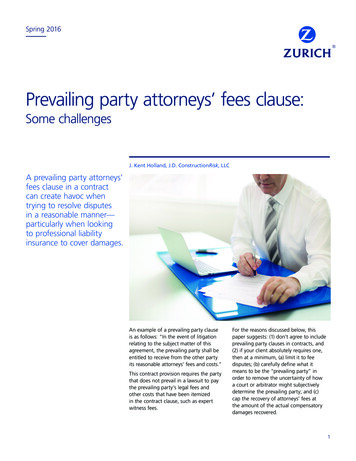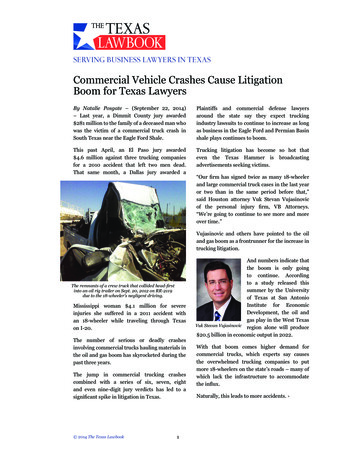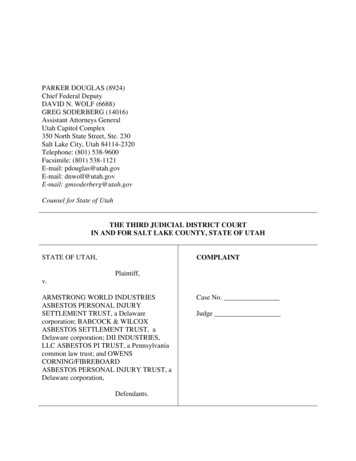
Transcription
PARKER DOUGLAS (8924)Chief Federal DeputyDAVID N. WOLF (6688)GREG SODERBERG (14016)Assistant Attorneys GeneralUtah Capitol Complex350 North State Street, Ste. 230Salt Lake City, Utah 84114-2320Telephone: (801) 538-9600Facsimile: (801) 538-1121E-mail: pdouglas@utah.govE-mail: dnwolf@utah.govE-mail: gmsoderberg@utah.govCounsel for State of UtahTHE THIRD JUDICIAL DISTRICT COURTIN AND FOR SALT LAKE COUNTY, STATE OF UTAHSTATE OF UTAH,COMPLAINTPlaintiff,v.ARMSTRONG WORLD INDUSTRIESASBESTOS PERSONAL INJURYSETTLEMENT TRUST, a Delawarecorporation; BABCOCK & WILCOXASBESTOS SETTLEMENT TRUST, aDelaware corporation; DII INDUSTRIES,LLC ASBESTOS PI TRUST, a Pennsylvaniacommon law trust; and OWENSCORNING/FIBREBOARDASBESTOS PERSONAL INJURY TRUST, aDelaware corporation,Defendants.Case No.Judge
Plaintiff State of Utah complains against Defendants Armstrong World Industries AsbestosPersonal Injury Settlement Trust (“AWI”), Babcock & Wilcox Asbestos Settlement Trust(“B&W”), DII Industries, LLC Asbestos PI Trust (“DII”), and Owens Corning/FibreboardAsbestos Personal Injury Trust (“Owens”) (collectively “Defendants”) and alleges as follows:INTRODUCTION1.Utah brings this action under Utah Code § 26-20-14(16) to enforce civil investigativedemands (“CIDs”) against Defendants.See Exhs. A-D (Cover Letters and CivilInvestigative Demands).2.Utah Code § 26-20-14 allows the Attorney General to take investigatory action if he hasreason to believe that: a person has information or custody or control of documentarymaterial relevant to the subject matter of an investigation of an alleged violation of theUtah False Claims Act, Utah Code Section 26 Chapter 20; a person is committing, hascommitted, or is about to commit a violation of the Utah False Claims Act; or it is in thepublic interest to conduct an investigation to ascertain whether a person is committing, hascommitted, or is about to commit a violation of the Utah False Claims Act.3.Utah issued the CIDs on information and belief that abuse of asbestos trusts is occurring,and to investigate whether Defendants are engaged in mismanagement and abuse ofasbestos trusts.4.Plaintiffs’ attorneys across the country are using asbestos trusts to obtain significantmonetary recovery for claims, even where they would fail in the tort system. The abuseinjures states by improperly draining the trust assets, precluding future legitimate claimants
from relying on asbestos trusts, and leaving states with the high cost associated withasbestos-related disease. Further, there are questions surrounding the Medicare SecondaryPayer statute regarding whether asbestos trust handlers are ensuring that medical assistanceprograms are being reimbursed for payments made from the trusts.5.For these reasons, and in accordance with 42 U.S.C. § 1396a(a)(25)(A), Utah issued theCIDs as part of a joint Medicaid fraud investigation into possible mismanagement ofasbestos trusts.6.Currently over sixty companies have established trusts, including all the manufacturers ofthe most dangerous and dusty asbestos-containing products, and includes the Defendants inthis action. These trusts have paid out roughly 17 billion since 2008.7.The trusts are overseen by Trust Advisory Committees (“TACs”) and Future ClaimsRepresentatives (“FCRs”). The TACs, comprised of asbestos plaintiffs’ attorneys largelyfrom a handful of prominent firms, have outsized power over the billions of dollars in thetrust system. They represent a large proportion of current asbestos claimants, and so voteon their behalf in approving the governing documents. Thus, the evidentiary requirementsfor claims—such as the claimant’s work history and proof of exposure—are primarilycontrolled by the same attorneys who collect contingency fees on millions of dollars ofclaims paid from a trust each year.8.This power imbalance in the asbestos trust system creates problematic incentives for thoserunning the trusts and results in lax requirements for claims.
9.Plaintiffs’ attorneys across the country themselves have acknowledged that the trustsrequire far less than is needed to prove a case in the tort system.10.The lack of oversight in the trust system compounds these issues. A late-1990s audit of theManville Trust, for instance, revealed that forty-one percent of claimants to that trust hadeither no disease or a less severe condition than they had alleged in their claim forms, withfalse rate claims of sixty-three percent for the doctors claimants used most often.11.Subsequent revelations have been equally troubling. When an Ohio court ordered aplaintiff’s trust submissions disclosed in his tort case, the trust form showed that he hadmade very different statements regarding his work and exposure history to the trust than hehad sworn to in his court case. Kananian v. Lorrillard Tobaco Co., Case No. CV 442750,Cuyahoga Cty., Ohio (January 18, 2007). Similarly, in Koeberle v. Alfa Laval (No. 20090887 Pa. Commw. Ct.), the plaintiff denied exposure to insulation, boilers, andconstruction products in court, and won a 4.5 million award against gasket, valve, andpacking product manufacturers. Less than three months later, plaintiff’s counsel filed trustclaims alleging exposure to the very insulation, boiler, and construction products to whichthe claimant had so recently denied exposure, and the trusts compensated him for thoseclaims. Likewise, the plaintiff in Ginter v. Anderson Vreeland, Inc. (No. 2010-4061, N.Y.Sup. Ct.) was compensated by thermal insulation trusts after denying exposure to thoseproducts at his trial.12.These examples are not isolated and troublingly appear to be widespread and ongoing.The federal court overseeing the bankruptcy of Garlock Sealing Technologies, Inc. found
that some law firms had engaged in “suppression of evidence” when their clients were“unable to identify exposure in the tort case, but then later (and in some cases previously)were able to identify it in Trust claims.” In re Garlock Sealing Techs, LLC, 504 B.R. 71,86 (Bankr. W.D.N.C. 2014).13.Other very recent studies have analyzed specific and ongoing worrisome aspects of theasbestos trust system. A study of trust claims filed by plaintiffs who also sued CraneCompany, a Wisconsin manufacturer of asbestos-containing products, showed that eightypercent of those trust claim forms involved exposures not disclosed to Crane in theprevious tort case. A December 2015 study of claims released in the Garlock bankruptcyrevealed that it was possible to make profoundly inconsistent exposure allegations in thetort and trust systems by delaying filing of trust claims until the conclusion of the courtcase. A February 2016 study, also using the Garlock claims as its sample set, showedserious discrepancies in the allegations made from trust to trust in twenty-one percent ofthe claims.14.The record evidence from these cases suggests that asbestos trusts often are not sufficientlyrigorous in scrutinizing their claims. Such possible lack of oversight also raises questionsas to whether the trusts and claimants attorneys are ensuring that medical assistanceprograms are being reimbursed once the trust pays claimants who have also receivedcompensation from those programs.15.Pursuant to federal and state law, anyone who receives payments from a third party (suchas a defendant or trust) must reimburse Medicare and Medicaid for any payments made by
those programs for the injury or the illness which was the basis of the claimant’s recovery.42 U.S.C. § 1395y(b)(2). Failure to promptly make reimbursements is a violation of theMedicare Secondary Payer Statute, id., and also violates the federal False Claims Act incertain circumstances. 31 U.S.C. § 3729 et seq. In addition, under Utah’s false claimsstatute, anyone who knowingly causes a false statement to be made or used in order toavoid the obligation to reimburse a medical assistance program may be liable for per-claimpenalties and treble damages. Utah Code § 26-20-9.5(2)(c)(i).16.Utah—as all states—is required to take all reasonable measures to ascertain the legalliability of third parties for health care services provided to Medicaid beneficiaries and hasa responsibility to investigate and seek reimbursement for medical assistance programpayments. To that end, Utah utilizes the powers vested by statute to initiate investigationsand pursue civil and criminal actions to vindicate wrongs perpetrated by those against thestates. While it seems beyond question that trust assets are being depleted much fasterthan anticipated, the scope of the harm caused by the claiming practices described in thepreceding paragraphs has not yet been quantified.17.While not assuming that Defendants recipients of the CIDs in fact have violated the law,Utah issued the CIDs in question in this case in accordance with the authority granted theUtah Attorney General in Utah Code § 26-20-14(1), (2) in order to scrutinize Defendantasbestos trusts for possible instances of waste, fraud, or abuse and in order to ensure thatculpable entities, not Utah, sister states or blameless businesses, bear the high costsassociated with asbestos-related diseases. Most importantly, oversight of trust practices
will help ensure that compensation remains available for future patients of asbestos-relateddiseases.JURISDICTION AND VENUE18.This Court has jurisdiction over this action by direct operation of statute, Utah Code § 2620-14(16), Utah Rule of Civil Procedure 54 (judgments), as well as pursuant to Utah Code§§ 78A-5-101, 102 (general jurisdiction and original jurisdiction).19.This Court has specific personal jurisdiction over the Defendants under Utah Rule of CivilProcedure 17, as each Defendant-Trusts’ alleged misconduct—fraud on all future Utahclaimants and on the State itself—inextricably links the alleged misconduct to Utah.Furthermore, the Defendant-Trusts have paid Utah claimants. Consequently, Defendantshave physically entered Utah in person or through an agent, goods, mail, or some othermeans, which are among the activities that constitute sufficient contacts for specificpersonal jurisdiction.20.Venue is proper in this judicial district pursuant to Utah Code § 78B-3-307 becauseDefendants’ alleged fraud on the state of Utah under investigation in the CIDs is withinthis judicial district.PARTIES21.Plaintiff State of Utah is one of the fifty sovereign states forming the United States ofAmerica, having been admitted to the Union on January 4, 1896 on an equal footing withother states. Power to bring suit on behalf of Utah is partially vested in the AttorneyGeneral, who is responsible for seeing that the laws of Utah are faithfully executed and is
empowered by statute to investigate and prosecute legal proceedings to protect the interestsof the state, including those detailed herein. Utah Const. art. VII, § 16; Utah Code § 67-51.22.Defendant Armstrong World Industries Asbestos Personal Injury Settlement Trust(“AWI”) is a Delaware corporation with a mailing address of P.O. Box 1079, Wilmington,Delaware 19899-1079.23.Defendant Babcock & Wilcox Asbestos Settlement Trust (“B&W”) is a Delawarecorporation with a mailing address of P.O. Box 8890, Wilmington, Delaware 19899-8890.24.Defendant DII Industries, LLC Asbestos PI Trust (“DII”) is a Pennsylvania common lawtrust, and is a “Qualified Settlement Fund” within the meaning of Treasury Departmentregulations issued pursuant to Section 468B of the Internal Revenue Code, with a mailingaddress of DII Industries, LLC Asbestos PI Trust, P.O. Box 821628, Dallas, Texas 75382.25.Defendant Owens Corning/Fibreboard Asbestos Personal Injury Trust (“Owens”) is aDelaware corporation with a mailing address of Owens Corning Fibreboard AsbestosPersonal Injury Trust, P.O. Box 1072, Wilmington, Delaware 19899-1072.STATEMENT OF FACTS26.Plaintiff mailed a CID to Defendant AWI pursuant to the authority granted under UtahCode § 26-20-14 in a letter dated December 12, 2016. See Exh. A.27.Plaintiff mailed a CID to Defendant B&W pursuant to the authority granted under UtahCode § 26-20-14 in a letter dated December 12, 2016. See Exh. B.
28.Plaintiff mailed a CID to Defendant DII pursuant to the authority granted under Utah Code§ 26-20-14 in a letter dated December 12, 2016. See Exh. C.29.Plaintiff mailed a CID to Defendant Owens pursuant to the authority granted under UtahCode § 26-20-14 in a letter dated December 12, 2016. See Exh. D.30.The terms of the CID issued to AWI required AWI to tender completed responses,verification(s), and document production by hand delivery or mail to the Office of the UtahAttorney General, Utah State Capitol Complex, 350 N. Main Street, Ste. 230, Salt LakeCity, Utah 84114-2320, on the 28th Day of February, 2017 at 11:00 a.m.31.The terms of the CID issued to B&W required B&W to tender completed responses,verification(s), and document production by hand delivery or mail to the Office of the UtahAttorney General, Utah State Capitol Complex, 350 N. Main Street, Ste. 230, Salt LakeCity, Utah 84114-2320, on the 28th Day of February, 2017 at 11:00 a.m.32.The terms of the CID issued to DII required DII to tender completed responses,verification(s), and document production by hand delivery or mail to the Office of the UtahAttorney General, Utah State Capitol Complex, 350 N. Main Street, Ste. 230, Salt LakeCity, Utah 84114-2320, on the 28th Day of February, 2017 at 11:00 a.m.33.The terms of the CID issued to Owens required Owens to tender completed responses,verification(s), and document production by hand delivery or mail to the Office of the UtahAttorney General, Utah State Capitol Complex, 350 N. Main Street, Ste. 230, Salt LakeCity, Utah 84114-2320, on the 28th Day of February, 2017 at 11:00 a.m.34.Defendant AWI has failed to comply with the CID issued by Utah.
35.Defendant B&W has failed to comply with the CID issued by Utah.36.Defendant DII has failed to comply with the CID issued by Utah.37.Defendant Owens has failed to comply with the CID issued by Utah.38.Defendants AWI, B&W, DII, and Owens, through counsel, have informed the Office of theUtah Attorney General that they will not comply with the CIDs each Defendant received.39.Utah Code § 26-20-14(17) provides: “The attorney general may file a complaint in districtcourt for an order to enforce the civil investigative demand if [] a person fails to complywith a civil investigative demand.”40.Each Defendant is a “person” under Utah Code § 26-20-14, as specified in Utah Code §26-20-2(6).41.Utah Code § 26-20-14(17) provides: “Failure to comply with a final order entered underSubsection (17) is punishable by contempt.”42.Each Defendant has indicated that it will not comply with an order issued by this Court toenforce the CIDs issued and received by each Defendant.FIRST CAUSE OF ACTIONOrder to Enforce CIDs Pursuant to Utah Code § 26-20-14(17)43.Plaintiff incorporates the allegations contained in paragraphs 1-42 above.44.Each Defendant has failed to comply with the terms of the CIDs each received.45.Each Defendant has indicated it does not intend to comply with the CIDs each received.46.Plaintiff is entitled to and seeks an order from this Court to enforce the CIDs issued to eachDefendant.
SECOND CAUSE OF ACTIONOrder of Contempt Pursuant to Utah Code § 26-20-14(18)47.Plaintiff incorporates the allegations contained in paragraphs 1-46 above.48.Each Defendant has indicated that it will not comply with an enforcement order issued bythis Court.49.Plaintiff is entitled to and seeks an order of contempt from this Court against eachDefendant.WHEREFORE, having pled its causes of action against the Defendants, Plaintiff prays forjudgment as follows:A.On Plaintiff’s First Cause of Action, for judgment and order against each Defendant toenforce the terms of the CIDs issued each Defendant.B.On Plaintiff’s Second Cause of Action, for judgment and order of contempt in the eventDefendants do not comply with this Court’s judgment and order of enforcement.C.For an award of Plaintiff’s costs and attorneys’ fees incurred herein.F.For other further relief as this Court deems just and equitable.DATED this 7th day of March, 2017.By:/s/ Parker DouglasParker DouglasChief Federal DeputyOffice of the Utah Attorney GeneralCounsel for Plaintiff
EXHIBIT ACover Letter and Civil Investigative Demands toArmstrong World Industries Asbestos Personal InjurySettlement TrustDated December 13, 2016
December 13, 2016Armstrong World Industries Asbestos Personal Injury Settlement TrustAttn: Trustee and Legal DepartmentP.O. Box 1079Wilmington, DE 19899-1079Dear Trustee:For the reasons explained below, the undersigned Attorneys General supportthe attached civil investigative demand in order to learn more about how the asbestostrust is operating and to ensure that no fraud is being committed.Congress adopted Section 524(g) of the Bankruptcy Code 1 in response to a rapidgrowth of asbestos litigation that began in the mid-1980s. As you are aware, thisstatute allows defendants in the asbestos tort system to declare bankruptcy and fundan asbestos personal injury bankruptcy trust. The debtor then emerges frombankruptcy free of its asbestos-related liabilities, which the trust assumes. Currentlyover 60 companies have established trusts, including all the manufacturers of themost dangerous and dusty asbestos-containing products. These trusts have paid out 17 billion since 2008.As chief legal officers for our respective states, we are concerned about potentialabuse of the asbestos trusts. Plaintiffs’ attorneys are using the trusts to obtainsignificant monetary recovery for claims, even where they would fail in the tortsystem. The abuse injures our states by improperly draining the trust assets,precluding future legitimate claimants from relying on the trust, and leaving stateswith the high cost associated with asbestos-related disease. Further, there arequestions surrounding the Medicaid Secondary Payer statute and whether the trusthandlers are ensuring that medical assistance programs are being reimbursed forpayments made from the trust.A recent court decision raises serious questions regarding whether the trustshave implemented any measures to address this lack of scrutiny over claims. Thefederal court overseeing the bankruptcy of Garlock Sealing Technologies, Inc. foundthat some law firms had engaged in “suppression of evidence” when their clients were111 U.S.C. § 524(g).
“unable to identify exposure in the tort case, but then later (and in some casespreviously) able to identify it in Trust claims.” 2This evidence suggests that the trusts are not sufficiently rigorous inscrutinizing their claims. This lack of oversight also raises questions as to whether thetrusts and claimants attorneys are ensuring that state medical assistance programsare being reimbursed once the trust pays claimants who have also receivedcompensation from those programs.For these reasons, the undersigned Attorneys General support the attached civilinvestigative demand.Sincerely,SEAN D. REYESUtah Attorney GeneralBRAD D. SCHIMELWisconsin Attorney GeneralALAN WILSONSouth Carolina Attorney GeneralJEFF LANDRYLouisiana Attorney GeneralLESLIE RUTLEDGEArkansas Attorney GeneralADAM LAXALTNevada Attorney GeneralPATRICK MORRISEYWest Virginia Attorney GeneralDEREK SCHMIDTKansas Attorney GeneralTIM FOXMontana Attorney General2In re Garlock Sealing Techs, LLC, 504 B.R. 71, 86 (Bankr. W.D.N.C. 2014).
BILL SCHUETTEMichigan Attorney GeneralMARTY J. JACKLEYSouth Dakota Attorney GeneralDOUGLAS J. PETERSONNebraska Attorney General
CID No. 1-AIDecember 13, 2016To:Armstrong World Industries Asbestos Personal Injury Settlement TrustP.O. Box 1079Wilmington, DE 19899-1079SERVE:Attn: Trustee and Legal DepartmentCIVIL INVESTIGATIVE DEMANDPursuant to Utah Code § 26-20-14, the Attorney General for the State of Utah, inconjunction with Attorneys General from states of Wisconsin, as well as the WisconsinDepartment of Agriculture, Trade and Consumer Protection hereby comma
Defendant Owens Corning/Fibreboard Asbestos Personal Injury Trust (“Owens”) is a Delaware corporation with a mailing address of Owens Corning Fibreboard Asbestos Personal Injury Trust, P.O. Box 1072, Wilmington, Delaware 19899-1072. STATEMENT OF FACTS 26. Plaintiff mailed a CID to D
